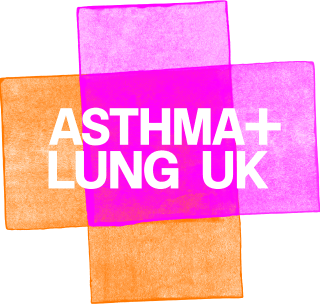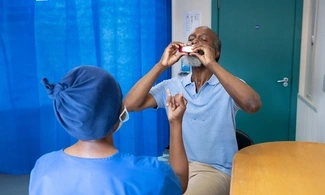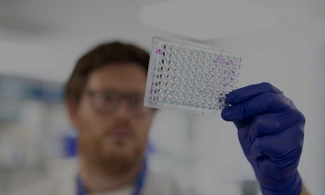- Why your child needs asthma medicines
- Asthma inhalers for children
- Add-on treatments for your child’s asthma
- If your child has an asthma attack
- Asthma treatment for babies, toddlers and children under five
- Referral to specialist care
- Do asthma medicines have side effects?
- Help your child’s asthma medicines work well
Asthma treatment guidelines for children
The latest asthma guidelines from NICE (National Institute for Health and Care Excellence) say that:
- all babies, children, teens and young adults with asthma or suspected asthma need treatment with inhaled steroids
- no one with asthma should be prescribed only a blue reliever inhaler.
Speak to your GP surgery about your child’s asthma inhalers so you can feel confident they’re on the best treatment plan.
Why your child needs asthma medicines
“With the right treatments and support, your child can enjoy school, playing, and sports, without asthma symptoms getting in the way. Dr Andy Whittamore, Asthma + Lung UK’s GP.
Asthma causes inflammation and swelling in your child’s airways. This makes your child more likely to react to their asthma triggers. Their airways get tight, narrow and more inflamed, so it’s harder for them to breathe.
- Steroid preventer medicines aim to lower your child’s risk of asthma symptoms by stopping their airways getting inflamed and swollen.
- Asthma reliever medicines can be life-saving if your child has an asthma attack.
When your child’s asthma preventer medicines are working well, you should notice that they:
- have no symptoms during the day
- sleep better because symptoms are not waking them up at night
- need to use their reliever inhaler less often
- do not have asthma attacks
- can get on with daily life (including playing, sports and going to school) without asthma symptoms getting in the way.
Use an asthma action plan
Using an action plan makes it easier to manage your child’s medicines and help them stay well with their asthma.
Your child’s asthma action plan tells you:
- what medicines your child takes every day to help them stay well
- what to do if your child’s asthma is getting worse
- how to treat your child if they have an asthma attack.
You can also note down any triggers and allergies that make your child’s asthma worse.
Make sure your child’s school, and anyone else caring for your child, has an up-to-date copy of their asthma action plan.
Find out more about action plans for children.
Asthma inhalers for children
“Whichever inhaler your child is prescribed, they need to understand what it’s for, know how and when to use it, and feel happy using it. Ask your GP, nurse or pharmacist to show your child how to use their inhaler.’ Dr Andy Whittamore, Asthma + Lung UK’s GP.
Inhalers let your child breathe in their asthma medicine. This means the medicine gets straight into their airways where it’s needed.
All children with asthma need an inhaler with:
- a steroid preventer medicine to prevent inflammation in their airways and
- a bronchodilator reliever medicine to open up their airways quickly if they have symptoms or an attack.
They might have these medicines in two separate preventer and reliever inhalers, or in one combination inhaler, called MART (Maintenance and Reliever Therapy).
MART is a special type of combination inhaler that can also be used as your child’s reliever inhaler. MART is licensed for children over 12. But it is also recommended by clinical guidelines as an ‘unlicensed’ inhaler for some children under 12 if your child’s GP thinks they would benefit from it.
If your child has a metered dose inhaler (MDI), using a spacer makes it easier for them to use their inhaler and get the medicine they need. It also helps prevent side effects like a sore mouth.
Make sure your child has good inhaler technique by watching our inhaler videos. You can also ask your GP or pharmacist to show them the best way to use their inhaler.
Preventer and reliever inhalers
When your child starts asthma treatment, they’ll usually have two inhalers, one to take every day, and one to take when they have symptoms or an asthma attack.
- The inhaler they take every day is called a preventer inhaler. It contains a low dose of steroid medicine. The steroid medicine (called corticosteroid) is a copy of the steroids made naturally by our bodies. It treats the inflammation in your child’s airways. If your child takes their preventer inhaler every day as prescribed, they’re less likely to react to their asthma triggers.
- If they get symptoms or have an asthma attack, they should take their reliever inhaler. This type of inhaler is usually blue, so some people call it their blue inhaler. Others call it their rescue inhaler, or SABA (short acting bronchodilator). Your child’s reliever inhaler opens up their airways quickly if they have symptoms or an attack. Make sure it’s always close by, so you or your child can treat symptoms quickly.
Help your child use their preventer inhaler every day as prescribed to lower their risk of inflammation, and to prevent symptoms and asthma attacks.
If your child takes their preventer inhaler as prescribed, they should not need to use their reliever inhaler much, or at all.
MART (Maintenance and Reliever therapy) inhalers
If your child is prescribed MART, they have just one inhaler.
MART (maintenance and reliever therapy) is recommended for children over 12 with asthma. If your child is younger than that, aged 5-11, your child’s GP or nurse may prescribe MART if:
- their asthma is not well controlled using separate preventer and reliever inhalers.
- their GP or nurse feels confident they can manage a MART treatment plan.
A MART inhaler can lower the risk of symptoms and asthma attacks. This is because each time your child uses it to relieve symptoms, they also get a dose of steroid preventer to treat inflammation in their airways.
Your child uses their MART inhaler:
- every day as prescribed to prevent symptoms
- as their reliever inhaler if they get symptoms or have an asthma attack.
They will start off on a low dose of steroid medicine in their MART inhaler. If your child needs extra support, their GP can prescribe a slightly higher dose.
MART inhaler technique
Your child’s MART inhaler may be a pressurised metered dose inhaler (pMDI) or a dry powder inhaler(DPI).
If your child has a DPI, the inhaler technique is different to the metered dose inhaler your child might be used to.
Your child does not need a spacer if they have a DPI. Ask your GP, nurse or pharmacist to show you and your child the best way to use their inhaler.
If your child finds it difficult to use their DPI when they have an asthma attack, ask their GP or nurse about having an emergency blue reliever inhaler and spacer as well.
It’s safe for your child to use an emergency blue inhaler even if they’re on a MART plan and usually use a different reliever inhaler. For example if their school keeps a blue reliever inhaler for emergencies only.
If your child is over 12 and only has occasional symptoms
If your child is over 12 and only has occasional symptoms, they may be prescribed AIR (anti-inflammatory reliever) therapy. This is when they have an inhaler to use only when they have symptoms.
An AIR inhaler contains a steroid medicine and a bronchodilator medicine called formoterol. This can open up your child’s airways quickly if they have symptoms or an asthma attack.
Add-on treatments for your child’s asthma
An add-on treatment is an extra medicine your child takes for their asthma. They still need to take their usual medicines.
Your child’s GP or nurse may prescribe add-on medicines if:
- your child’s asthma is not well controlled with a preventer and reliever inhaler
- your child cannot manage a MART treatment plan well maybe because they’re not able to use this type of inhaler easily.
Your child's GP or nurse should review any new treatments after 8 to 12 weeks. If one type of add-on treatment does not seem to make a difference to your child, they can try another one.
A long-acting beta-2 agonist (LABA)
Your child’s GP or nurse may prescribe another type of inhaler with a long-acting beta-2 agonist (LABA) medicine in it as an add on treatment.
A LABA is a type of long-acting bronchodilator medicine that relaxes your child’s airways. Because it’s long-acting, it helps to keep your child’s airways relaxed and open for longer. This makes it easier for them to breathe.
If your child is prescribed a LABA medicine, they must have steroid preventer medicine too.
It’s safer for them to have a combination inhaler with their steroid preventer medicine and the LABA medicine together in one inhaler. This helps make sure your child is getting the steroid preventer medicine they need to keep down inflammation in their airways.
Unless your child’s steroid LABA combination inhaler is a MART inhaler, your child will need a blue reliever (SABA) inhaler as well.
Check with your child’s GP, nurse or pharmacist if you’re not sure what type of combination inhaler they have.
Montelukast tablets or granules
Your child’s GP or nurse may prescribe montelukast as an add on treatment.
Montelukast is a preventer medicine. It comes as chewable tablets or granules. Your doctor might call it a leukotriene receptor antagonist (LTRA).
Your child needs to take montelukast every day alongside their usual preventer inhaler or LABA combination inhaler.
Your child’s GP or nurse will want your child to try montelukast for 8 to 12 weeks to see if it makes a difference. If your child is getting side effects, they may stop it sooner.
It’s important to be aware of possible side effects, including nightmares. Talk to your child’s GP or nurse if you’re worried about any side effects from montelukast.
Find out more about montelukast.
Before prescribing add-on treatments
your child’s GP or asthma nurse will first:
- check your child is taking all their usual medicines regularly
- check their inhaler technique
- ask you about any triggers and how well your child is avoiding them.
If your child has an asthma attack
If your child has an asthma attack, they need to use their reliever inhaler. This will be either their blue reliever or their MART inhaler.
Always carry your child’s reliever inhaler with you so they can use it quickly if they get symptoms or have an attack.
Your child needs to have their reliever inhaler in school too, in case they have symptoms or an asthma attack during the school day. Find out more about asthma at school.
“Your child must have an inhaler they can use easily in an asthma attack. Some children find it hard to use a dry powder inhaler (DPI) when they’re feeling very breathless. Speak to their GP or nurse if your child cannot safely use their DPI. Their GP or nurse can give them a blue reliever inhaler and spacer to use in an emergency. Dr Andy Whittamore, Asthma + Lung UK’s GP.
If your child needs to go to hospital
If your child has an asthma attack and needs to go to hospital, paramedics may give them reliever medicine through a nebuliser.
They may also need a short course of steroid tablets to treat their asthma attack.
Do not use a nebuliser to treat your child’s asthma attack at home unless their specialist has recommended it. Using a nebuliser at home can hide symptoms getting worse and delay seeking urgent help.
Call 999 if:
your child’s reliever inhaler is not helping.
If you do not have their reliever inhaler with you, and your child is struggling to breathe, call 999 straight away.
Asthma treatment for babies, toddlers and children under five
It’s hard for children under five to do the usual asthma tests, so they may not have a definite asthma diagnosis yet.
Until your child can do asthma tests, their GP or nurse can regularly review their symptoms and treatment.
Your child’s GP or nurse may think your child has asthma based on their symptoms, but they cannot diagnose them without tests.
If your child has symptoms like wheezing, noisy breathing, a cough or feeling breathless, their GP or nurse may say they have suspected asthma.
They can start treatment with:
- a low dose steroid preventer inhaler to take twice a day
- a reliever inhaler to deal with symptoms or an asthma attack
This is usually a trial of 8 to 12 weeks to see if asthma medicines make a difference. Your GP or nurse may call this a ‘trial of treatment’.
If the trial of treatment helps
If the medicines helped your child’s symptoms, their GP or nurse will want to stop the medicines for a few months to see if the symptoms come back without the medicine.
Try not to worry about this. Your child’s GP or nurse can restart the asthma treatments straightaway if your child’s symptoms come back.
They may need to repeat the trial. This is so they can make sure they’re not giving your child medicines unnecessarily, before they have a confirmed asthma diagnosis.
If the trial of treatment does not help
If your child’s symptoms do not get better with asthma medicines, their GP or nurse can look into other reasons for their symptoms.
But first they’ll want to make sure your child is taking their inhaler in the best way and sticking to their routine of taking it every day.
They’ll also look at any triggers that could be making your child’s symptoms worse, like mould, house dust mites, or pollution.
If they’re not sure what’s causing your child’s symptoms, they may refer them to a specialist.
Referral to specialist care
A small number of children with asthma may need specialist support and treatments. Their GP or nurse can refer them to a specialist respiratory pediatrician if their asthma is uncontrolled even though they have been taking asthma treatments:
Your child may be referred to a specialist if they have lots of asthma symptoms and:
- need their reliever inhaler three or more times a week
- wake up at night with symptoms at least once a week
- have had an asthma attack needing steroid tablets.
Do asthma medicines have side effects?
Most medicines have side effects but not every child will get them. Some side effects are more common than others.
Tell your GP or asthma nurse about any side effects your child is getting. There could be a simple way to reduce or treat the side effects, so they can carry on taking the medicine and getting the benefits for their asthma. For example, good inhaler technique, including using a spacer if you’ve been given one, helps prevent some common side effects like a sore mouth.
Your child’s asthma medicines lower their risk of an asthma attack so it’s important to keep taking them. Never reduce your child’s asthma medicine without first speaking to their GP or asthma nurse.
If your child stops taking their preventer inhaler, they’ll be more at risk of symptoms and asthma attacks.
We answer common questions about your child’s asthma treatments, including any worries about side effects.
Take your child to their asthma review
Take your child to their regular asthma review so you can check they’re still on the best dose of their medicine to keep their symptoms under control, and to keep the risk of any side effects low.
It’s important to take your child to all of their asthma reviews, even if they feel well. They may be able to reduce the medicine they’re taking if their asthma has been well managed and they’ve had no symptoms.
Make sure your GP makes a note of any changes to the medicines your child needs to take on their asthma action plan.
Help your child’s asthma medicines work well
You can help your child manage their asthma, and help their asthma medicines work well by:
- encouraging your child to do sports and keep active
- helping your child eat healthily and keep to a healthy weight
- helping your child avoid asthma triggers like pollution, mould and cigarette smoke
- making sure your child has any vaccinations they’re eligible for, like flu. Colds and flu are one of the main asthma triggers.
- not smoking around your child, or letting others smoke near them
- supporting your child with any emotional stress or anxiety.
We have more advice on managing your child’s asthma, including helping your child to look after their own asthma as they get older.

Get support
Call or email our helpline for support with your asthma. Get advice on medicines, symptoms or travelling with a lung condition. You can also find support through our groups.








